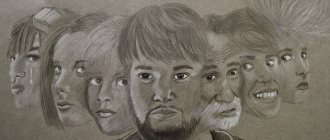Crowd Psychology
- a branch of social psychology that studies the behavior of groups of people and the differences between the behavior of groups and the behavior of individual individuals.
History knows many examples of large groups of people being able to produce dramatic and unexpected social changes, bypassing the usual mechanisms and patterns. Such events often lead to conflicts. Scientists have developed several different theories to explain crowd psychology[1].
Types of Crowds
Crowds can be divided depending on the activity (the crowd itself) or the passivity of the participants (public, audience). The crowd is classified according to the dominant behavior of the participants.
- An aggressive crowd is a rioting and lynching crowd characterized by aggression towards people or objects.
- Panic crowd[2] - the dominant form of behavior of fleeing crowds is panic, as, for example, in the case of a fire in a theater.
- The acquisitive crowd is similar to the fleeing crowd in that both are involved in competition for a certain scarce object.
- An expressive crowd is a community of people distinguished by the special power of mass manifestation of emotions and feelings (love, joy, sadness, sadness, grief, indignation, anger, hatred, etc.). An expressive crowd is usually the result of a transformation of a casual
or
conventional crowd
[2][1]. - and others.
Crowd effect
Which people are still trying to prove their isolation from the animal world? If you are such a person, then you will love this article! It is the “crowd effect” that proves that humans belong to the animal world. So what is the crowd effect?
In addition to some physiological properties that humans and animals share, we have some common psychological qualities. We should start with what everyone knows: a person’s actions are regulated by his subconscious processes, attitudes, beliefs, instincts, and so on. Conscious processes also influence human life, but most of the time of the day a person seems to be “sleeping” in a waking state. And when a person once again falls into “sleep”, that is, his conscious control of the situation is turned off, the unconscious comes into force. And here the most interesting thing begins: a person shows the same habits as wild animals, while any moral and disciplinary programs that society tries to build into every person from birth disappear.
So, you “fell asleep” - your subconscious is in charge! You already know what it will do, since you perform your actions automatically every time (these are your habits), they have long been fixed and cannot be judged (at least by you personally). Being alone, you still act more or less wisely, even at the “automatic” level. But as soon as you go out into society, into the crowd, you become “one of the sheep.”
Don't believe me? Then watch other people in the crowd. You will see that almost all the people are doing the same thing as the crowd. Or take your own example: how do you behave among friends? Can you say that all your actions are strictly under your control? When they pour it for you, you drink it. When they give it to you, you eat. When you are told, you listen. In the crowd you lose yourself, “dissolve” and become one of the cogs of the group. You do the same thing as the people around you.
There are many examples. In any war there were people who were not ready to lay down their lives just to please the whims of their sovereign. However, because they were part of the crowd, no one cared about their interests. Where everything is, that’s where you should go.
A group of guys beat up one person. It is very rare, but it happens that there are participants who do not want to beat an innocent person (especially since the battle is unequal). However, due to the fact that such a participant found himself in a crowd of his friends, he is obliged to support their actions... otherwise he may get punched in the face himself.
You are at a concert. The music is loud and pretty girls come out to dance on stage. Someone in the crowd begins to whistle defiantly, and is picked up here and there. As a result, you also whistle at unfamiliar girls when your beloved woman is standing next to you.
The “crowd effect” is a clear indicator of what a person really is. If you saw yourself from the outside, you would be ashamed, saying: “If I were alone, I would never have done this!” However, in the crowd, all your dirt and inner essence, which has no barriers in the form of morality and ethics, came out of your subconscious. You are ready to kill, rob, destroy and rape, even if you don't really want to. In a crowd you think you can do anything - and this is true. You can finally do all the things you couldn't do alone. It’s the same in nature: all herd animals obey this effect: “Where everyone goes, everyone goes there individually.” Don't you consider yourself an animal? This means that you are simply ashamed to look at yourself from the outside!
Patterns
Despite the lack of unity of opinion among researchers, the characteristics of the crowd most often include:
- spiritual unity or "mental homogeneity";
- emotionality;
- irrationality[1].
Gustave Le Bon explained the spiritual unity of the crowd by the mechanism of infection - the mechanical spread of affect from one member to another, like an infectious disease. Other researchers, like Stanley Milgram and Toch, believed that the apparent mental homogeneity of crowds could also be explained by the mechanism of convergence: individuals who think and feel alike tend to gather together and form a crowd. Thus, homogeneity precedes rather than follows from membership in a crowd. Two mechanisms are thought to explain the emotional and irrational nature of crowds:
- loss of liability due to anonymity;
- impression of universality[1].
How the masses are manipulated and why people are drawn into protests. Clear policy
Mass manipulation. Who makes the crowd dance to their tune and why? Human psychology and the influence on the subconscious using mental techniques. Who are the sellers of illusions, and how do they deceive people, drawing them into protests?
About psychology and methods of influencing the masses in “Understandable Politics”
Four years ago, the BBC published a piece called “The Majority Effect: Why We Get Stupid in Crowds.” Its author, Michael Bond, tried to figure out how it happens that seemingly intelligent people alone become extremely aggressive and irrational when they gather in large numbers.
- We’ll come back to the British article and look at it in general:
- How do people manipulate and what do psychologists have to do with it?
- What influence does the crowd have on our behavior and thinking?
- Why can you lose your “I” in it in just a couple of minutes?
- Finally, who, how and why controls the crowd effect?
Crowd Control
The topic of crowd control is not new.
People thought about how to transform a mass of people into a driving force and use it for their own purposes back in ancient times. But the modern contours of the crowd as a protest phenomenon began to emerge clearly after a series of revolutions in the 18th and 19th centuries. One of the first to study the topic was the Frenchman Gustave Le Bon. In his work “Psychology of Peoples and Masses” he formulated this very psychology in just a few sentences. Gustave Le Bon, French psychologist: “The crowd has never strived for the truth; she turns away from evidence that she does not like, and prefers to worship error, if only this error seduces her. He who knows how to mislead the crowd easily becomes its ruler; whoever strives to reason with her always becomes her victim.”
Democracy is alien to the crowd - it needs a leader
The saying is several centuries old, but as we see, the essence has not changed.
By the way, it was Le Bon who tried to justify the onset of the “era of the masses” and was quite successful in this. The main postulate of the French psychologist is “democracy is alien to the crowd - it needs a leader.” By the way, Adolf Hitler actively used the Frenchman’s work. For example, simplified and memorable slogans that must be fed to the masses: “One people, one Reich, one Fuhrer.” The rest are already known, and I don’t want to say them on air. Oksana Kalaganova, psychologist, gestalt therapist:
Anonymity and contagion - properties of the crowd
In his work, Le Bon identified several factors that determine the properties of the crowd:
- Firstly, anonymity - there are no names or social statuses in the crowd. Personality dissolves here, and such facelessness sometimes leads to a feeling of irresponsibility.
- Secondly, infection. A person is subject to psychic influence and strives to imitate - to do what others are doing.
The Frenchman's ideas were supported by the Spaniard José Ortega y Gasset.
Yes, it was his book “The Revolt of the Masses” that has created a lot of noise lately. Moreover, it seems that not everyone understands what it is about. And the philosopher just criticizes the phenomenon. Jose Ortega y Gasset, Spanish philosopher: “The masses are those who float with the flow and are devoid of guidelines. Therefore, the mass man does not create, even if his capabilities and strengths are enormous.” The crowd wants bread and illusions. Many scientific works are devoted to this. For example, Freud believed that in a crowd a person’s level of mentality decreases. That is, the ability to think. Remember the popular saying “Everyone ran and I ran” - this is precisely a sign of that same mental infection.
Crowd Control Experiment
In the 1950s, Harvard psychologist Solomon Asch demonstrated that people often accept the majority view, even if it is obviously wrong, and even if it means denying their own feelings. But let's return to Michael Bond's article. The journalist agreed to be part of a crowd control experiment. The testing ground for psychological testing was not a laboratory, but the most British place on earth - a London pub. For the experiment, participants were given a password to a special website on which they could move a cursor point using their phone. The first time - one by one, and the second - the data is visible to everyone. As a result, the question “Should Britain leave the EU?” individually everyone answered “YES”, and in a mass vote “NO”. The scientist explains this by saying that group decisions are more biased and less reasonable - people simply accept the point of view of the majority. In other words, people are easily influenced in masses and crave obedience to a strong leader. Why? It’s simple: relieve yourself of responsibility, get rid of fear and the supposedly hated present in the name of some future. And it turns out that even the smartest and most reasonable “lose” their “I” in the crowd and dissolve in its emotions and ideas. Alexey Avdonin, BISI analyst: Of course, not all, but most of the mass and spontaneous protests are destructive. Have you ever seen a crowd in one impulse go to improve a public garden, for example, or help an orphanage? Much more often - smashing shop windows, attacking police officers, or setting cars on fire.”
Crowd structure
Over many years of study, the characteristic layers of the crowd have been clearly described.
For example, the instigators, or the core of the crowd - they clearly understand what they are doing and consciously manipulate the masses. Inconspicuous conductors will find a way to take people where they want them to go. The main thing is that you go outside. It is ordinary residents who are the second layer - that is, suggestible, or receptive people. And those who came on purpose, and random participants who are initially neutral, but are exposed to the general mood. And of course, in the crowd, as a rule, there are a number of crazy people who do not think about the consequences. This is the third layer. Most dangerous. Hooligans are the most antisocial individuals who join the crowd for purely destructive purposes. As a rule, their actions cause the crowd to become aggressive and capable of the most dangerous actions.
In order to gather a crowd today, it is not necessary to walk along the streets with banners. You can even be in another country. The Internet and screaming messages there are quite enough. Throw the bait to the audience and wait for it to bite.
Daniel Richardson, researcher at University College London:
“We think of the Internet as an information highway.” In fact, this is the highway along which our false ideas travel. "Twitter and Facebook are great tools for sharing information, but it's possible that our tendency to use them to spread prejudice is actually making us all dumber."
The crowd has only emotions and feelings, no intelligence
Meet Arsen Dallakyan. He spoke a lot about crowd psychology and mass behavior on various resources.
The head of the Russian Behavioral Department is confident that the crowd has only emotions and feelings. There is no consciousness, mentality, or intellect. But the leader has all this, and he controls the masses at a primitive level. People who know the properties of a crowd well try to avoid these same crowds in every possible way.
Arsen Dallakyan, managing partner of the behavior design agency:
“If you want to express your civic position and go out there, you must understand that you will not be there! You will go out there like a cell of a large organism. If you are ready to lose yourself, to sacrifice yourself at least for a while, go. But I feel sorry for myself, losing. I have a feeling that I will be ashamed later when I am left alone with myself. And some people have absolutely no self, they only feel like they are someone in the crowd.”
As psychologists say, in an aggressive crowd, “a person falls several steps on the ladder of civilization.” Becomes bolder, more aggressive and reckless. He can commit actions that he would never dare to do in ordinary life: destroy, insult, and sometimes take life. It's like a hangover the day after a feast. Eric Hoffer, American philosopher:
“Mass movements are usually accused of deceiving their participants: of depriving them of the opportunity to enjoy the present with hopes for the future. But for those who are dissatisfied, the present is already irreparably distorted: conveniences and pleasures cannot improve the present for them. Only hope can bring them a sense of true pleasure.”
It’s easy to manipulate a crowd – we’ve already figured that out. People are charged with a sense of passion, a desire for change here and now. For example, the famous “freedom.equality.brotherhood”, “factories for workers, land for peasants”, or “Europe, we are with you”, “I/WE” - you just need to substitute a number or a person’s name. The templates are written and known. All that remains is to choose the right one.
Oksana Kalaganova – psychologist, gestalt therapist
And it turns out that the leaders who manipulate the crowd are “sellers of illusions,” and the crowd doesn’t need anything more. Promises caress the ear, for example, about salaries of three thousand euros, certainly successful reforms, and so on. How to achieve this? It doesn’t matter at all - such promises are a disposable product.
An extremely interesting and effective technique used by political strategists is “the pull of the majority towards the opinion of the majority.” This is not a reservation, that’s what it’s called. Based on an imaginary demonstration of a high percentage of protest and an allegedly meager level of support for the current government. You don’t have to look far for an example: the game of percentages is being actively imposed on society during the current campaign.
Alexey Avdonin, BISI analyst
This method is supported by stuffing through social networks and statements by so-called opinion leaders. An ordinary person is psychologically inclined to listen to a public figure. It doesn’t matter what he says, the main thing is that it’s emotional and colorful. By the way, by playing on emotions you can mold a person into anything. The German film “The Wave” showed this well.
How to rock a crowd
Let's look at another important tool: circular reaction.
For example, if you find yourself among a lot of people laughing loudly, you will also start having fun loudly. Arriving at a rock concert, the audience falls into collective ecstasy. And this can be stimulated, say, they came to a rally, experienced fear, followed by horror... and then aggression. This is how they rock the crowd towards riots. And here it’s quite paradoxical. Experts assure: the most “swinging” part of the population is always the middle class and wealthy people. As Hoffer argues, the poor are glad that they can simply survive. And those who have at least something will look for opportunities to get more and more.
Eric Hoffer, American philosopher:
“Our dissatisfaction is greater when we have a lot and want even more than when we have nothing and want little. We are less dissatisfied when we lack many things than when we lack one thing.”
And lastly, why are people willing to die for an idea? And are there such things in principle? Yes and no. After all, a mass movement to change the world for the better gives its participants the most dangerous weapon: it disregards moral standards and restrictions. As they say, everything is suitable for the fire of world revolution.
And here is the crowd effect: after all, to suffer for an idea means to be part of good. And all others are bad. No individuality, no gray morality: we are the warriors of light, they are the harbingers of darkness. The mind is asleep and has given itself to the collective. Clouding of consciousness - this phrase has become firmly established in everyday life. This is what the same Hoffer says.
Eric Hoffer, American philosopher:
“We must be especially careful “on days when hopes and dreams rush through the streets - they are usually harbingers of disaster.”
You will have to be personally responsible for all actions
As you already understand, anything can happen in a crowd, whether organized or spontaneous.
Crush, injuries and even death. Therefore, it is important not to go to crowded places. If you find yourself, you need to get out. And if you came intentionally, remember that everyone will have to be personally responsible for all actions. No one will judge the crowd. The crowd effect has been and will always be there. This is our biology, psychologists emphasize. This means that in all the diversity of opinions, calls and slogans - in simple terms, it is important to listen to yourself and think with your head. Knowledge related to mass psychology is fraught with many opportunities and threats. Even an ordinary flash mob can be turned step by step into fire and violence.
Arsen Dallakyan, Managing Partner of Behavior Design Agency
How to avoid being infected by the crowd effect?
The term "psychic contagion" is indeed popular in the theory of mass control. People turn into a crowd in the same way as they become ill with, say, coronavirus: the infection of lack of will and madness spreads from one person to another, spreading wider and wider. If so, it turns out that the protective measures should be the same. First, social distancing, of course. Well, of course, purity of hands, thoughts and intentions. And, of course, caution - without it you definitely can’t protect yourself from any infection. I hope this will be clear to you now.
Crowd Psychology Theories
Carl Jung laid down the basic concepts of the collective unconscious. Other famous researchers of crowd psychology are Gustave Le Bon, Wilfred Trotter, Gabriel Tarde, Sigmund Freud, Elias Canetti.
Classical theories
Sigmund Freud's main idea about crowd psychology is the hypothesis that people in a crowd act differently from people who think individually. The minds of a group of people unite into a kind of collective mind. As a result, the enthusiasm of each member of the group increases, and the interests of one individual become less significant for himself when acting in a crowd.
The mental state of an individual in a crowd is characterized by a sharp increase in the influence of the following factors [3]:
- Increasing the emotionality of perception of everything he sees and hears.
- Increased suggestibility and decreased degree of critical attitude towards oneself and the ability to rationally process perceived information.
- Suppressing a sense of responsibility for one's own behavior.
- Emergence of a sense of power and awareness of anonymity.
Gustave Le Bon characterized the soul of the crowd this way:
| The most striking fact observed in a spiritualized crowd is this: whatever the individuals who compose it, whatever their mode of life, occupation, character or intelligence, their mere transformation into a crowd is enough for them to form a kind of collective a soul that makes them feel, think and act completely differently than each of them would think, act and feel individually. There are ideas and feelings that arise and turn into actions only among the individuals who make up the crowd. The spiritualized crowd is a temporary organism formed from heterogeneous elements, united together for an instant, just as the cells that make up a living body are united and through this connection form a new being, possessing properties different from those possessed by each cell in the separately. |
How to protect yourself from manipulation?
An individual ceases to control his behavior as soon as he gets into the crowd and becomes himself again as soon as he leaves it. You can fully realize your potential, reveal your talent, and bring benefits only through individual activity. But there is a problem: one in the field is not a warrior. There is only one way out - do not succumb to outside manipulation.
Forewarned is forearmed. Here are 9 popular psychological techniques that subtly but surely influence people.
Presupposition.
This is one of the most used NLP models, which allows speech to create “a reality in which only the desired behavior options exist.” Presupposition helps to gently convince a person that something will definitely happen.
For example, a politician agitates voters: “When I am president, I will do...”. And he doesn’t even discuss the option that this won’t happen.
Flattery.
A simple but effective “below the belt” technique, with which the manipulator tries to put the other in a good mood and use it to his advantage. Here we work on the opponent’s self-esteem: compliments, encouragement, words of gratitude.
For example, a manager convinces employees to go to work on a day off: “I know that you are responsible workers, so you can spend your day off and do urgent work.”
Pre-selection.
It works on the principle: choose the lesser of two evils. On the one hand, there are no prohibitions and there is the right to choose. But on the other hand, there are no other answer options other than those proposed.
For example, in advertising we are asked: “Do you choose Fanta or Sprite (burger or cheeseburger)?” Although both brands belong to the same manufacturing company.
Inspiration.
Inspiration helps you work tirelessly, make discoveries, and believe in your superpowers. So when manipulators want to persuade someone to achieve a feat, they organize inspiration for him.
For example, before a battle, the commander tells the soldiers: “What you are doing is necessary! You will succeed! Everything for peace on earth!”
Emotional attack.
Playing on emotions is a simple way to get the right actions from employees, relatives, and friends. This is repeated repetition of the same demands, a change in intonation, an attempt to promote feelings of guilt.
For example, a teacher shames the class: “I treated you like adults, but you let me down. Do you know how the director scolded me because of you?”
Social proof.
The so-called herd instinct is remembered by most residents of the Soviet Union, who stood in line only because it was a symbol of scarcity. “If everyone takes it, it means it’s a good thing,” thinks a person who does not want or does not have time to understand the situation.
For example, when people want to choose from a large number of gadget models, they rely on ratings and reviews. And they don’t even think that reviews are written by “their” employees from the manufacturing company.
The principle of mutual exchange.
The rule says: a person needs to return good for good. And since any obligations are depressing, you want to get rid of them as quickly as possible. Skilled manipulators take advantage of this - they provide a small service and wait for a response.
For example, religious sectarians hand out free literature on the street, and in return ask to listen to their instructions.
Motivation by fear.
Fear is a powerful human emotion and a sure-fire motivator. Therefore, in order to force a person to do something, you need to scare him properly “in advance”: talk about a future car breakdown or warn him about an article for theft.
For example, the work of insurance companies is based on intimidating people - the more intimidating examples are given, the more often insurance policies are purchased.
Nonverbal communication.
In a crowd, nonverbal signs (gestures, facial expressions, movements) are captured and transmitted much faster than words. Therefore, manipulators add emotions and colors with posture, intonation, friendly gestures, and laughter.
For example, world dictators convinced people before they began to speak: they stood taller than their listeners in order to look down on them. They complemented their performances with sweeping movements and active movement around the hall - in order to take up as much space as possible and further confirm their importance.
Mass psychology is more often associated with manipulation, dictatorship, and mind control. But this area of psychology has positive aspects - the organization of festivals, carnivals, and festive processions, which help to plunge into the crowd and take a break from the burden of restrictions and responsibilities. Another thing is that such mass events must be carefully organized. Otherwise, you can destroy something you need. Bastille, for example.
Take the test: Self-Esteem Scale










